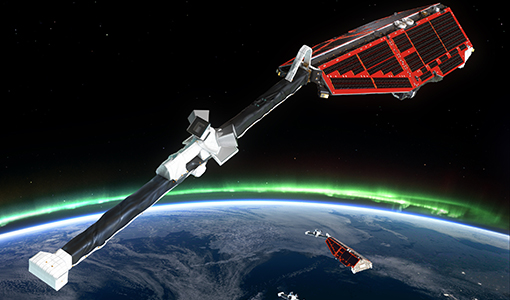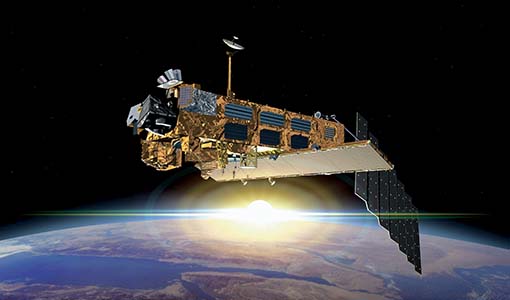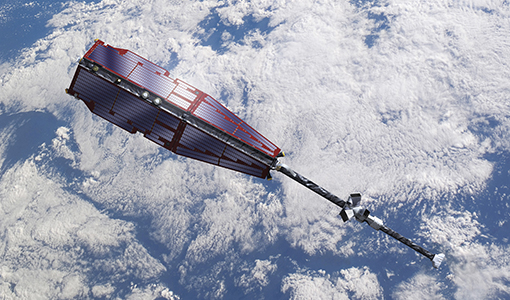- All Categories (67186)
- Data (320)
- News (717)
- Missions (84)
- Events (206)
- Tools (61)
- Activities (77)
- Campaigns (106)
- Documents (65615)
NEWS
Discover the latest news on the European Space Agency's Earth Observation activities. Learn all about new data availability and how ESA's missions are performing.
News - Maintenance News
Maintenance on the eoPortal on 9 May 2024
A maintenance activity is scheduled on the eoPortal from 07:00 to 13:30 UTC on 9 May.
News - Spotlight on EO community
Spotlight on Third Party Mission provider: EUSI
European Space Imaging (EUSI) is one of ESA’s suppliers of commercial Very High Resolution (VHR) satellite imagery for scientific research in Earth Observation (EO).
News - Data Release news
Cryo-TEMPO gets new Summer Sea Ice product
CryoSat’s remarkable 14-year record of global ice and sea levels got another upgrade with the release of Cryo-TEMPO baseline C, which includes lots of new features and improvements.
News - Maintenance News
ESA Envisat AATSR - dissemination maintenance on 30 April 2024
A planned software maintenance activity will affect ESA’s Envisat AATSR data dissemination platform on Tuesday 30 April 2024 from 07:30 to 08:30 UTC
News - Maintenance News
Maintenance on EO websites on 25 April
A maintenance activity is scheduled for Earth Online websites on 25 April.
News - Data Release news
Additional EFI TII Cross Track Flow dataset 0302 available for Swarm
Additional TII cross-track flow data is now available on the Swarm dissemination server for all the Swarm satellites.
News - Operational News
Swarm Bravo on-board anomaly on 10 April 2024
Due to an issue on-board Swarm Bravo, the vector magnetic field data from the VFM instrument are not available from 10 April 2024 at 12:54 to 11 April 2024 at 10:27 (UTC time).
News - How to guides
How to access campaign data distributed by ESA
Access to datasets from ESA’s Campaigns are openly available following submission of a Data Access Request.
News - Data Release news
New Ocean data and more boost CryoSat data platform
Eight new datasets have been added to the CS2EO platform to support, enhance, and simplify research using CryoSat data. They include the CryoSat Ocean Product, and the Cryo-TEMPO Land Ice, Sea Ice, Polar Ocean, Coastal Ocean and Inland Water datasets.
News - Maintenance News
ESA EO Services - Maintenance on 17 April 2024
A planned software maintenance activity will affect the ESA EO Sign-In Authentication Service on Wednesday 17 April 2024, from 06:30 to 13:00 UTC.
News - Maintenance News
EO-CAT software maintenance - 15 April 2024
A scheduled software maintenance will affect ESA's Earth Observation Data Catalogue EO-CAT on Monday 15 April 2024 from 07:30 to 08:30 UTC.
News - Maintenance News
Maintenance on EO websites on 11 April
A maintenance activity is scheduled on EO websites from 16:00 to 16:15 UTC on 11 April
News - Events and Proceedings
Featuring the power of Earth observation data at EGU
The European Geosciences Union General Assembly 2024 brings together geoscientists from all over the world, aiming to provide a forum where scientists and early career researchers can present their work and discuss their ideas with experts, in all fields of geoscience.
News - General News
Earth scientists better exploit Swarm data with virtual workspace
The ESA-funded Swarm virtual workspace is helping scientists make the most of a decade of valuable magnetic field data.
News - General News
ESA's improved Earth system data records: what is in store for the future?
Fundamental Data Records (FDRs) are instrumental in advancing our understanding of Earth systems and for addressing societal challenges effectively. These long-term records contain uncertainty-quantified, calibrated and geo-located multi-instrument/multi-platform satellite sensor data spanning several decades to support climate-related applications.
News - Spotlight on EO community
Meet the Earth Online Editorial & Graphics Services Team
The Earth Online Editorial Service produces diverse publications, which facilitate ESA and TPM data discovery and exploitation, ensuring that the website maintains a returning and ever-growing user base.
News - Maintenance News
ESA data dissemination maintenance – 10 April 2024
A planned software maintenance activity will affect ESA’s ERS and Envisat (A)SAR data dissemination service on 10 April 2024.
News - General News
New Swarm Field Aligned Current web tool available
We are pleased to announce that a new Field Aligned Currents (FAC) web tool is available
News - Maintenance News
GEOSAT-2 Spain Coverage maintenance on Dissemination Service from 2 to 4 April 2024
A software maintenance activity has been scheduled between 2 and 4 April 2024 for the GEOSAT Spain Coverage data collections.
News - How to guides
HEDAVI Discover: a step-by-step guide
The Heritage Data Visualisation tool (HEDAVI) is a platform developed by the French Science Consulting for Earth Observation group, VisioTerra, which allows users to freely access over 40 years of ESA Earth Observation Heritage data, Third Party Missions and some Copernicus data.



